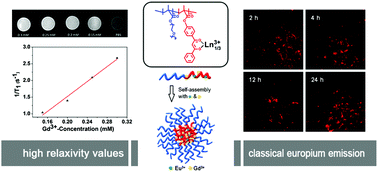Novel lanthanide–polymer complexes for dye-free dual modal probes for MRI and fluorescence imaging†
Abstract
High-resolution imaging is a powerful technique in theranostics and staging of tumors. Dual-modal imaging using lanthanide hybrid nanoparticles as probes has been attracting increasing attention due to their specific and intrinsic physical properties. The present work reports a novel water-soluble micelle of an amphiphilic block copolymer with diketone pendants chelating gadolinium (Gd3+) and europium (Eu3+) cations as a dual probe for magnetic resonance imaging (MRI) and fluorescence imaging for clinical detection. The Gd3+ and Eu3+ hybrid micelles have homogeneous size distribution and hydrodynamic diameters tunable between 80 and 220 nm. The macromolecular diketone ligand enhances the relaxation rate of Gd3+ and sensitizes Eu3+ luminescence efficiently. Further sensitized by the co-doped Gd3+, the Eu3+ complex exhibits a long-lived emission with a large Stokes shift. A strong red light at a wavelength of 614 nm is observed with an excitation in the range of 350 and 405 nm. Cellular uptake experiments reveal excellent biocompatibility and rapid uptake of the nanoparticles by MCF-7 cells. The robust dual-modal probes are promising in applications for early diagnosis of tumors, presurgical planning, and intraoperative fluorescence-guided surgery.


 Please wait while we load your content...
Please wait while we load your content...